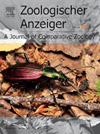意大利特有水田鼠的系统地理学和种群遗传学
IF 1.2
3区 生物学
Q2 ZOOLOGY
引用次数: 0
摘要
Arvicola 属在南北美洲分布广泛,有两种生态形式--陆生和水生--是该属的特征。在欧洲有两个物种:分布最广的 A. amphibius 和意大利特有的 A. italicus。这项研究的目的是描述意大利水田鼠的遗传结构和变异性,以及意大利东北部种群的遗传特征,该地区是小型哺乳动物物种的接触区,具有重要的生物地理意义。对该属进行的系统发育分析证实了主要群体的存在,这些群体大多与已描述的物种和支系相对应。关于意大利标本,来自意大利东北部一个种群的个体被归入 A. amphibius,揭示了该物种在意大利的存在,因此,在意大利东北部可能存在 A. italicus 和 A. amphibius 之间的假定接触区。该系统发育将意大利东北部的第二个种群纳入到 A. amphibius 中,但该种群处于基部位置,支持率较低。该种群与意大利蛙和两栖蛙的分化值处于种内分化和种间分化的临界点上。相反,微卫星数据支持两栖蛙与意大利蛙之间的明确区分,并将后者中模糊的线粒体世系包括在内。此外,这个东北种群的核位点显示出与中南部 A. italicus 种群混杂的证据,支持将这些标本归入 A. italicus。这种模式可能表明,意大利东北部的 A. italicus 保留了一个祖先单倍型,与南部种群经历了很长一段时间的隔离,直到近代才进行基因交流。在 A. italicus 中,混杂情况表明北部种群的分化程度最高,与中南部种群混杂的证据有限。对于意大利特有的小型哺乳动物来说,种内多样性从南到北逐渐降低。最后,在北部种群中观察到的低遗传多样性对于像 Arvicola 这样生活在支离破碎的栖息地并容易受到栖息地丧失影响的物种来说具有挑战性;因此,为这种鲜为人知的特有小型哺乳动物确定合适的保护措施变得非常重要。本文章由计算机程序翻译,如有差异,请以英文原文为准。
Phylogeography and population genetics of the endemic Italian water voles, Arvicola italicus
The genus Arvicola has a wide palearctic distribution and present two ecological forms – terrestrial and aquatic – characterizing the genus. In Europe two species are present: the most widespread, A. amphibius and A. italicus, endemic to Italy. The aim of the study was to describe the genetic structure and variability in A. italicus and the genetic identity of populations in northeast Italy, an area of biogeographic importance as contact zone for small mammal species.
Thirty-six Italian water voles, displaced in population from south to north of Italy, were analysed by two mitochondrial markers and 8 autosomal microsatellite loci. The phylogenetic analysis on the genus confirmed the presence of major groups mostly corresponding to the species and clades already described. About the Italian specimens, the individuals from one population in northeastern Italy resulted included in A. amphibius revealing the presence of this species in Italy and, in consequence, the possible presence of a putative contact zone between A. italicus and A. amphibius in the northeast. The phylogeny includes a second population from northeast Italy within A. amphibius, but in basal position and with a low support. The values of divergence of this lineage from A. italicus and A. amphibius lie on the threshold between intraspecific and interspecific divergence. Conversely, microsatellite data support a clear distinction between A. amphibius and A. italicus and includes the ambiguous mitochondrial lineage in this latter species. Furthermore, this northeastern population shows evidence of admixture of nuclear loci with the southcentral A. italicus populations, supporting the attribution of these specimens to A. italicus. This pattern could suggest that A. italicus in northeast Italy retained an ancestral haplotype and undergone a long period of isolation respect to the southern populations, without genetic exchange until recent times. Within A. italicus, the admixture shows northern population as the most differentiated showing limited evidence of admixture with the most diverse southcentral. The intraspecific diversity decreases from south to north as expected for an endemic small mammal in Italy. Finally, the low genetic diversity observed in the northern population can be challenging for a species as Arvicola living in fragmented habitats and susceptible to habitat loss; consequently, became important identifying suitable conservation measures for this barely known endemic small mammal.
求助全文
通过发布文献求助,成功后即可免费获取论文全文。
去求助
来源期刊

Zoologischer Anzeiger
生物-动物学
CiteScore
2.80
自引率
7.10%
发文量
75
审稿时长
>12 weeks
期刊介绍:
Zoologischer Anzeiger - A Journal of Comparative Zoology is devoted to comparative zoology with a special emphasis on morphology, systematics, biogeography, and evolutionary biology targeting all metazoans, both modern and extinct. We also consider taxonomic submissions addressing a broader systematic and/or evolutionary context. The overall aim of the journal is to contribute to our understanding of the organismic world from an evolutionary perspective.
The journal Zoologischer Anzeiger invites suggestions for special issues. Interested parties may contact one of the editors.
 求助内容:
求助内容: 应助结果提醒方式:
应助结果提醒方式:


